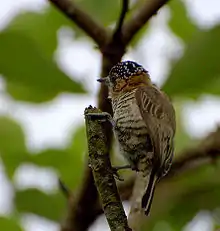Ochre-collared piculet
The ochre-collared piculet (Picumnus temminckii) is a species of bird in the family Picidae. It is found in Argentina, Brazil, and Paraguay. Its natural habitats are subtropical or tropical moist lowland forest, subtropical or tropical dry shrubland, and heavily degraded former forest.
| Ochre-collared piculet | |
|---|---|
 | |
| Male | |
| Scientific classification | |
| Kingdom: | Animalia |
| Phylum: | Chordata |
| Class: | Aves |
| Order: | Piciformes |
| Family: | Picidae |
| Genus: | Picumnus |
| Species: | P. temminckii |
| Binomial name | |
| Picumnus temminckii Lafresnaye, 1845 | |
Description
The adult ochre-collared piculet is between 9 and 10 cm (3.5 and 3.9 in) in length. The crown is mainly black with small white spots; the male has a red flecked or solid red fore-crown while the female does not. The nape and the sides of the neck form a cinnamon collar. The upper parts of the body are brownish and the flight feathers are chocolate. The tail is mostly black but the inner webs of the central two feathers are white, and the inner webs of the outer four feathers are whitish near the tip. The chin and throat are white with slight barring, and the underparts are white or cream heavily barred with black, especially on the lower belly. The iris is brown, the beak is black and slightly curved and the legs are grey.[2]
Distribution and habitat

The ochre-collared piculet is native to South America, its range extending from southeastern Brazil and eastern Paraguay to northeastern Argentina. It is a resident and sedentary species found at altitudes of up to 800 m (2,600 ft). Its habitat is mostly lowland rainforest with bamboos, vines and tangled growth, but it is also found in secondary growth, thickets, tall scrub, parks and gardens.[2] It hybridizes with the white-barred piculet where their ranges overlap.[3]
Ecology
The ochre-collared piculet forages through the undergrowth, including scrambling among vines, slender branches and saplings. Its diet is ants, beetle larvae and other small invertebrates. Its breeding habits have been little studied but it nests in a hole in a tree; one nest in São Paulo State in Brazil was 2.5 m (8 ft) above the ground and a male was seen attending it in October.[4]
Status
The ochre-collared piculet has a very wide range and is described as a fairly common bird. The population has not been quantified but the bird faces no particular threats, and the population trend appears to be stable, so the International Union for Conservation of Nature has assessed its conservation status as being of least concern.[1]
References
- BirdLife International (2016). "Picumnus temminckii". IUCN Red List of Threatened Species. 2016: e.T22680750A92875896. doi:10.2305/IUCN.UK.2016-3.RLTS.T22680750A92875896.en.
- Gorman, Gerard (2014). Woodpeckers of the World: A Photographic Guide. Firefly Books. pp. 70–71. ISBN 177085309X.
- McCarthy, Eugene M. (2006). Handbook of Avian Hybrids of the World. Oxford University Press, USA. p. 108. ISBN 978-0-19-518323-8.
- Winkler, H.; Christie, D.A.; Bonan, A. "Ochre-collared Piculet (Picumnus temminckii)". Handbook of the Birds of the World Alive. Lynx Edicions, Barcelona. Retrieved 23 April 2017.
